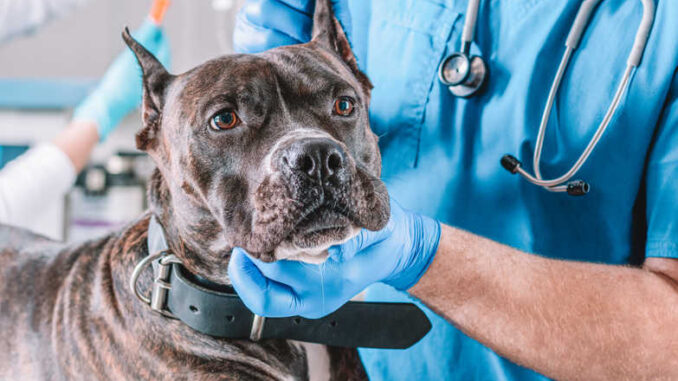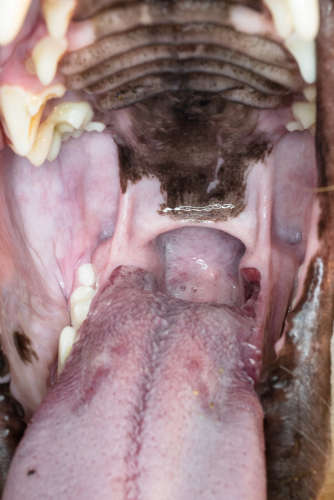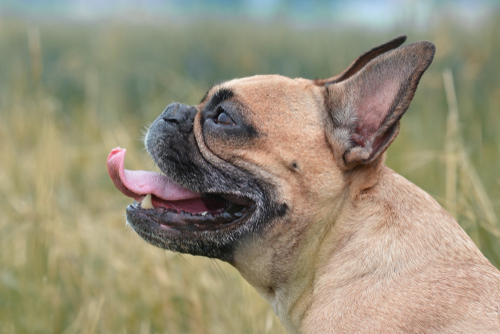
We see our share of brachycephalic breeds in our veterinary practice. After all, Pugs, Boston Terriers, and other flat-faced breeds are cute and cuddly. But they’re also prone to certain congenital abnormalities that can make breathing difficult. When I encountered dogs suffering from elongated soft palates, I would advise meeting with a board-certified veterinary surgeon to discuss soft palate surgery.

What is soft palate surgery?
One of the abnormalities that can affect brachycephalic dogs is an elongated soft palate. The soft palate is the fleshy, muscular tissue behind the bony part of the roof of the mouth. If the soft palate extends more than 3 mm past the epiglottis, it is classified as elongated.
Soft palate surgery is the removal of redundant or excess tissue to improve airflow and breathing. The video below shows a before (first 16 seconds) and after procedure:
The amputation can be done in one of four ways.
1. Traditional
The traditional method involves resecting the extra palate length with a sharp scalpel or Metzenbalm scissors and then sealing the edge with sutures. This method tends to result in more blood loss and more post-operative inflammation than other approaches.
2. Electrosurgery with a bipolar sealing device(BSD)
The BSD uses a combination of mechanical pressure and electrical current to seal vessels and tissue and cut away the unwanted section. Sutures are not needed with this method. There’s also less blood loss and swelling than with the traditional approach.
3. Electrosurgery with a fine-tip electrocautery unit
With electrocautery, an electrical current is used to amputate the extra tissue. The instrument’s heat cauterizes blood and lymph vessels resulting in minimal blood loss. This method produces less swelling during recovery, and sutures are usually not necessary.
4. Surgery with a CO2 laser
A CO2 laser allows for the precise excision of unwanted tissue. It vaporizes and cuts the edges while sealing blood vessels, nerve endings, and lymph vessels. As a result, your dog experiences less pain and swelling during recovery. Surgery time and blood loss are also less than when traditional methods are employed.
How will soft palate surgery help dogs with brachycephalic syndrome?

Dogs with brachycephalic airway syndrome usually suffer from a combination of defects, the most serious ones being:
- Stenotic nares or narrow nostril openings
- Elongated soft palate
- Hypoplastic trachea or smaller than normal tracheal opening
Each of these conditions can significantly impact your dog’s ability to breathe by increasing resistance in the airway. The laws of physics tell us that resistance in a tube is inversely related to the opening’s radius to the negative fourth power. That means an airway opening that’s ½ the normal radius will cause 16 times more resistance.
When dogs have a harder time breathing, it puts a strain on other organs and body systems, including the heart. Therefore, soft palate surgery and other procedures that increase your dog’s airway openings can
- Improve your dog’s breathing
- Improve your dog’s quality of life
- Reduce the risk of secondary complications like heat stroke and aspiration pneumonia
What happens if I don’t do the surgery? Can dogs live with an elongated palate?
Elongated soft palates can range from mild to severe. When the elongation is severe, surgery is the best treatment course. Correcting the abnormality early(before dogs are 2 years old) helps to prevent secondary conditions such as a collapsing trachea or heat stroke. Without surgical correction, longer soft palates can block the airway and disrupt breathing.
If your dog’s soft palate is mildly elongated, surgery may not be necessary. Medical management often works for dogs with infrequent, mild symptoms. When you elect to manage your pooch medically, treatment should include:
- Dietary management to prevent obesity
- Minimizing stress
- Using a harness rather than a collar to prevent putting pressure on the throat and neck
- Limiting exposure to humidity and heat
- Keeping your dog in air conditioning during the summer months
- Avoiding strenuous exercise
In some cases, dogs will respond well to this approach and continue to enjoy a good quality of life.
What are the signs that I shouldn’t wait to schedule surgery for my dog?
Signs that the palate is blocking the back of the throat and interfering with normal breathing indicate soft palate surgery is warranted. Contact your veterinarian for a consultation if you notice
- Excessive snoring
- Noisy breathing(stridor)
- Exercise intolerance
- Open-mouthed breathing
- Gagging/choking
- Vomiting or regurgitation
- Bluish tongue
- Fainting
What does soft palate surgery cost?
The cost of soft palate surgery in dogs varies depending on several factors.
- Your dog’s age
- Your dog’s size
- The location and type of veterinary practice performing the surgery
For an office visit and surgery, the cost can range from $500-2000 or more. If soft palate surgery is combined with other procedures to fix stenotic nares or other congenital defects, the cost may reach $5000.
While pet insurance can help you with many veterinary costs, many companies don’t cover inherited or breed-related conditions, including brachycephalic syndrome. If you plan to get a flat-faced breed, look for a policy that covers brachycephalic syndrome to help offset the costs of treatment.
What’s the success rate for elongated soft palate surgery?
The success rate for surgically managing an elongated soft palate is high for dogs that don’t have multiple defects. In a 2022 study evaluating CO2 laser soft palate surgery in 423 dogs, over 86% of the patients went home 1 day after surgery. More than 72% of dogs undergoing surgery showed improved respiratory signs.
It’s important to note that the success rate for surgery is best when treatment occurs early in your dog’s life. Correcting an elongated soft palate before your dog is 2 years old yields a better outcome and prognosis than with older dogs.
What are the risks and potential complications of soft palate surgery?
Soft palate surgery is not without risks. Possible complications of the surgery include:
- Post-operative swelling/inflammation can block the airway and cause respiratory distress
- Signs of heat stroke
- Aspiration pneumonia
- Need for a temporary tracheostomy to establish an airway
- Hemorrhage from amputated edges
- Vomiting or regurgitation
- Nasal discharge
- Infection
In the 2022 study cited above, 12% of dogs exhibited complications, but only about 3.3% suffered major complications of respiratory distress, aspiration pneumonia, or signs of heat stroke.
What age do dogs get soft palate surgery?
Soft palate surgery can occur in any age dog. Brachycephalic syndrome is usually diagnosed by the time your pup reaches 4 years old. However, if you and your veterinarian catch signs earlier, surgery can occur in dogs as young as 4 months. Earlier treatment may prevent secondary issues like laryngeal collapse or chronic upper airway disease.
Is soft palate surgery painful to dogs?
Soft palate surgery is painful to dogs because it involves the amputation of living tissue. However, non-traditional methods like electrosurgery and laser surgery tend to cause less postoperative pain. The discomfort is generally manageable with medications like butorphanol, acepromazine, or maropitant.
How do dogs recover from the surgery?
Following surgery, your veterinarian will monitor your dog closely for at least 12-24 hours for signs of respiratory distress. When respiratory distress develops, your veterinarian may perform a tracheostomy to establish a breathing pathwayThe tracheal breathing tube is usually left in the airway until the pooch regains consciousness and starts swallowing. Oxygen therapy is provided as needed.
Water can be offered in small quantities 12 hours after surgery. If your pup tolerates liquids, food can also be reintroduced.
Generally, the younger the dog, the better the recovery and outcome of the surgery. Dogs tend to enjoy a better quality of life, improved breathing, and improved exercise tolerance. Older dogs with a history of breathing problems have a poorer prognosis.
Are there good alternatives to the surgery?
If your dog has mild defects that minimally affect the airway, you may be able to manage it medically, but it will not correct the anatomical defects. Short-term relief may be possible with:
- Corticosteroids
- Nonsteroidal anti-inflammatory drugs
- Oxygen therapy
If your dog’s symptoms are moderate to severe, surgery is the best option.
Prevention: what can owners do to avoid this surgery or lower the risk for brachycephalic airway issues?
Because Brachycephalic syndrome is a congenital condition, there’s no way to prevent the primary anatomical defects. However, if you have a flat-nosed dog that’s at risk for the syndrome, you can take measures to help minimize symptoms and respiratory distress.
- Feed a diet to maintain lean body weight
- As much as possible, avoid heat and humidity
- Keep your dog in air conditioning and limit time outside during the summer months
- Avoid stressful situations
- Avoid strenuous exercise
- Use a harness rather than a collar or chain to prevent putting pressure on the trachea
Example of a dog with a brachiocephalic syndrome
Rufus was a French Bulldog. As a puppy, he started to develop a mild cough during exercise, so his owner consulted with his veterinarian. After diagnosing mildly stenotic nares and an elongated soft palate, the doctor and Rufus’ owner decided to try medical management.
Rufus was put on a diet to maintain a healthy weight, and the owner invested in a walking harness. The exercise was limited to walks in cooler weather. Fortunately, the owner’s home was equipped with central air conditioning, and Rufus was kept indoors during hot, humid periods.
While the approach helped for a while, over the next several months, Rufus began to snore and exhibit respiratory stridor. Eventually, he tired quickly when going for a walk. The veterinarian advised surgery when Rufus was about 1 year old. He recommended a specialist that could widen the nostrils and resect the elongated soft palate with a CO2 laser. Because Rufus was still young, the surgery was successful, and Rufus was soon breathing better and able to go for long walks with his owner.
Disclaimer: This website's content is not a substitute for veterinary care. Always consult with your veterinarian for healthcare decisions. Read More.


Be the first to comment